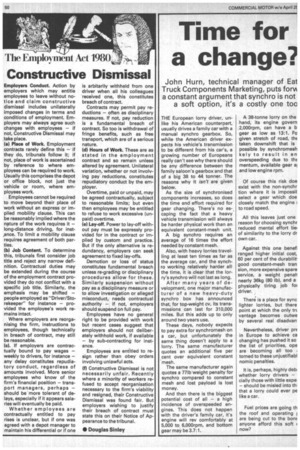Time for a change?
Page 54

If you've noticed an error in this article please click here to report it so we can fix it.
John Hum, technical manager of Eat Truck Components Marketing, puts forNA a constant argument that synchro is not a soft option, it's a costly one too
THE European lorry driver, unlike his American counterpart, usually drives a family car with a manual synchro gearbox. So, while the American driver expects his vehicle's transmission to be different from his car's, a growing number of Europeans really can't see why there should be any difference between the family saloon's gearbox and that of a big 38 to 44 tanner. The reasons why it isn't are given below.
As the size of synchronised components increases, so does the time and effort required for gear changing. There's no escaping the fact that a heavy vehicle transmission will always be harder physical work than an equivalent constant-mesh unit.
A big synchro requires an average of 16 times the effort needed by constant mesh.
Also, with heavy lorries travelling at least ten times as far as the average car, and the synchro working relatively harder all the time, it is clear that the lorry's synchro will not last as long.
After many years of development, one major manufacturer of a new heavy-duty synchro box has announced that, for top-weight cv, its transmissions can last for 310,000 miles. But this adds up to only around two years use.
These days, nobody expects to pay extra for synchromesh on a car, but unfortunately the same thing doesn't apply to a lorry, The same manufacturer quotes an additional five per .cent over equivalent constant mesh.
The same manufacturer again quotes a 771b.weight penalty for synchro compared to constant mesh and lost payload is lost money.
And then there is the biggest potential cost of all — a high incidence of overspeeded engines. This does not happen with the driver's family car, it's engine will rev comfortably at 5,000 to 6,000rpm, and bottom gear may be 3.7:1. A 38-tonne lorry on the hand, its engine govern .2,000rpm, can have a b gear as low as 13:1. Fo given stretch of road, the taken downshift that is possible by synchromesh kely to result in en overspeeding due to the mentum, available gear sl and low engine rpm.
Of course this risk doe exist with the non-synchr tion where it is impossit select a gear which doe closely match the engine to road speed.
All this leaves just one reason for choosing synchr reduced mental effort Id& of similarity to the lorry dr own car.
Against this one benefi ranged higher initial cost, 60 per cent of the durabilit. good constant-mesh tran sion, more expensive spare service, a weight penall nearly 36kg (80 lb), and a physically tiring job foi driver.
There' is a place for sync lighter lorries, but there point at which the only tri vantage becomes outwe by several real disadvan.
Nevertheless, driver pre in Europe to achieve ca changing has pushed it so the list of priorities, ope are becoming all too tomed to these unjustifiabl nomic penalties.
It is, perhaps, highly deb. whether lorry drivers — cially those with little expe — should be misled into th, that a lorry could ever pe like a car.
Fuel prices are going th the roof and operating are being cut to the bon( anyone afford this soft ( now?














































































































